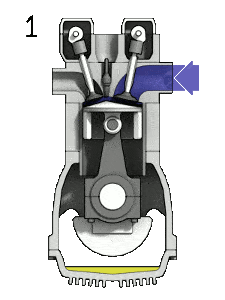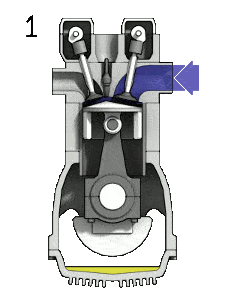Where You'll Find Wasted Sparks
Wasted sparks are produced in four-stroke (Otto cycle) engines, where the ignition system produces a spark on every revolution. This is called a ‘wasted spark’ because half of the sparks are created between the end of the exhaust stroke and the beginning of the intake stroke, where there is nothing to ignite, so those sparks are wasted. Wasted-spark systems are simpler than conventional distributor ignition systems, which makes them lighter, and more reliable. Wasted spark systems are most common on small one or two cylinder four-stroke engines, such as those found on lawnmowers, marine outboards, go-karts, and some generators.
Conventional Four-Stroke Engine (Otto) Cycle

- Intake (TDC->BDC)
- Compression (BDC->TDC) SPARK!
- Expansion (TDC->BDC)
- Exhaust (BDC->TDC)
Wasted Spark Four-Stroke Engine (Otto) Cycle

- Intake (TDC->BDC)
- Compression (BDC->TDC) SPARK!
- Expansion (TDC->BDC)
- Exhaust (BDC->TDC) SPARK!
Why Most Engines Don’t Use Wasted Sparks
Creating and sustaining a spark takes a little bit of energy, usually about 50mJ per spark, but ignition systems are usually only about 1% efficient. Ignition systems waste a lot of energy in powering their various components, so their total energy consumption is about 5J per spark. A small two-cylinder four-stroke engine idling at 1000 RPM will use about 50mL (1.7 oz.) of gasoline per hour just to create ignition sparks. Since waste sparks use almost as much energy as ignition sparks, a waste spark engine will waste almost as much fuel again! And this is just at idle!
Because waste sparks consume energy without producing anything useful, they reduce the engine’s efficiency and power output, while increasing fuel consumption (especially at low power settings). This decrease in fuel efficiency and power output is not acceptable unless the engine’s weight is extremely important.
Do Two-Stroke Engines Have Waste Sparks?
Two-stroke engines do not have wasted sparks, because they do not have an exhaust stroke. On a two-stroke engine, there is a compressed fuel-air mixture to ignite at top-dead-center on every revolution. This simple park timing makes distributors unnecessary on most two-stroke engines. That being said, some large and slow two-stroke engines do have distributors, but these are rare; we have only heard of a few still in use.
Two-Stroke Engine Cycle
- Intake/Compression (TDC->BDC) SPARK!
- Expansion/Exhaust (BDC->TDC)
Distributor-Less Ignition Systems (DIS)
‘Distributor-less ignition’ systems (also known as distributorless ignition systems) are those without a conventional high-tension distributor for spark timing. Before the advent of computer-controlled (ECU and ECM) ignition systems, ‘distributor-less four-stroke’ usually meant that the engine had a waste-spark system, with the spark plugs directly connected to a magneto. Modern engines use ECUs and ECMs to control coil-on-plug and coil-near-plug modules, which have one coil pack per cylinder, and no distributor. The bottom line is that distributor-less isn’t what it used to be!
That’s All!
If you’re looking for a fast, easy-to-use, and comprehensive way to test an ignition system, check out our GTC505 Engine Ignition Analyzer.
If you have any feedback for us, or ideas for topics we should cover in future blog posts, please send us an e-mail.